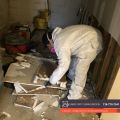A Guide to Moisture Meters and Thermal Imaging Cameras for Mold Detection and Moisture Problem

Effective mold detection and moisture management are crucial for maintaining a healthy and safe home environment. Two essential tools in this process are moisture meters and thermal imaging cameras. When used together, these technologies provide a comprehensive approach to identifying hidden moisture problems and potential mold growth. This guide explores how moisture meters and thermal imaging cameras work, their advantages, and how they are used in attic, roof, and wall inspections.
Moisture Meters and Thermal Imaging Cameras: Better Together
Moisture Meters
Moisture meters are handheld devices that measure the moisture content in various building materials, such as wood, drywall, and concrete. They provide accurate, real-time data on moisture levels, which is crucial for identifying areas at risk for mold growth.
Thermal Imaging Cameras
Thermal imaging cameras, also known as infrared cameras, detect temperature variations on surfaces, helping to identify hidden moisture. They work by capturing infrared radiation (heat) and converting it into a visual image that highlights temperature differences.
Synergy Between the Two
When used together, moisture meters and thermal imaging cameras offer a powerful combination for detecting moisture and mold:
- Moisture Meters provide precise readings of moisture content, confirming the presence of moisture detected by thermal imaging.
- Thermal Imaging Cameras allow for the quick scanning of large areas to identify potential moisture issues, which can then be verified with a moisture meter.
This combination ensures that no moisture problem goes unnoticed, leading to more effective mold prevention and remediation.
Thermal Imaging for Mold Detection and Moisture Problems
Thermal imaging is an invaluable tool for detecting hidden moisture and mold problems in homes. It works by identifying temperature anomalies that may indicate the presence of moisture behind walls, under floors, or in ceilings. Since mold thrives in damp environments, detecting moisture early is key to preventing mold growth.
How Thermal Imaging Works for Mold Detection:
- Identifying Cold Spots: Cold spots on a thermal image can indicate moisture accumulation, as wet areas tend to be cooler than dry ones.
- Locating Hidden Leaks: Thermal imaging can detect leaks that are not visible to the naked eye, such as those behind walls or under roofing materials.
- Visualizing Mold-Prone Areas: By highlighting areas of moisture, thermal imaging cameras help inspectors target specific locations for further mold testing and inspection.
Infrared Cameras for Moisture and Mold Inspections
Infrared cameras are particularly effective for comprehensive moisture and mold inspections, as they can quickly scan large areas and pinpoint moisture issues that may otherwise go undetected.
Benefits of Using Infrared Cameras:
- Non-Invasive: Infrared cameras allow inspectors to detect moisture without the need to damage walls, floors, or ceilings.
- Efficient: Large areas can be scanned quickly, making it easier to identify potential problems in a short amount of time.
- Accurate: By visualizing temperature differences, infrared cameras can accurately locate moisture hidden behind surfaces, even when it is not yet visible or causing damage.
Infrared cameras are especially useful in attics, roofs, and walls, where moisture issues are common but often hidden from view.
How to Detect Moisture and Mold With a Thermal Camera
Using a thermal camera for moisture and mold detection involves several key steps:
- Initial Scan: Start by scanning the area of concern with the thermal camera, looking for any temperature anomalies that may indicate moisture.
- Focus on Cold Spots: Pay particular attention to areas that appear cooler than their surroundings, as these may be signs of moisture accumulation.
- Verify with a Moisture Meter: Once a potential moisture issue is identified, use a moisture meter to confirm the presence of moisture and assess its severity.
- Document Findings: Capture thermal images and moisture readings to document the areas that need further inspection or remediation.
This process helps ensure that moisture and mold problems are accurately detected and addressed before they cause significant damage.
Advantages of Using Infrared Thermal Imaging Cameras in Home Inspections
Infrared thermal imaging cameras offer several advantages in home inspections, particularly when it comes to detecting moisture and mold:
- Early Detection: Thermal imaging allows for the early detection of moisture problems before they become visible or cause mold growth, saving homeowners from costly repairs.
- Comprehensive Coverage: The ability to scan large areas quickly makes thermal imaging ideal for inspecting roofs, attics, walls, and other parts of the home where moisture problems might develop.
- Improved Accuracy: By visualizing temperature differences, thermal cameras can detect moisture even in hard-to-reach or hidden areas, improving the accuracy of inspections.
- Non-Destructive Testing: Thermal imaging provides a non-invasive method of inspection, avoiding the need to cut into walls or other structures to find moisture.
Attic, Roof, and Wall Mold Inspection
Mold often begins in areas that are prone to moisture but are not frequently checked, such as attics, roofs, and walls. Thermal imaging cameras are especially useful in these areas:
- Attics: Poor ventilation and roof leaks can lead to moisture accumulation in attics, creating an ideal environment for mold. Thermal imaging can detect temperature differences that indicate moisture buildup, even in insulation or structural beams.
- Roofs: Infrared cameras can identify leaks in roofing materials that may not be visible from the exterior, preventing water from entering the home and causing mold growth.
- Walls: Moisture behind walls, often from plumbing leaks or exterior damage, can be detected with thermal imaging, allowing for early intervention before mold becomes a problem.
These inspections are crucial for maintaining a healthy living environment and preventing structural damage.
Case Study: Thermal Imaging and Moisture Detection in a San Francisco Home
Background
A San Francisco homeowner noticed a persistent musty smell in their living room but could not locate any visible signs of mold or water damage. Concerned about potential hidden moisture, they contacted Bay Area Mold Pros for a professional inspection.
Inspection
Certified inspector Rick Bruce conducted a thermal imaging scan of the home, focusing on the living room walls and ceiling. The thermal camera revealed cold spots in the ceiling that indicated moisture accumulation. Further investigation with a moisture meter confirmed elevated moisture levels, tracing the issue to a slow leak in the roof that had gone undetected.
Solution
Bay Area Mold Pros developed a remediation plan that included repairing the roof leak, drying the affected areas, and treating the ceiling for mold. The thermal imaging scan allowed for the early detection of the problem, preventing more extensive mold growth and structural damage.
Outcome
After the remediation, the musty smell disappeared, and follow-up inspections confirmed that the moisture problem had been fully resolved. The homeowner was pleased with the thorough and non-invasive inspection process, which saved them from more extensive repairs.
Mold Inspection and Testing in San Francisco
For homeowners in San Francisco, regular mold inspections are essential for maintaining a safe and healthy living environment. Moisture meters and thermal imaging cameras are critical tools in this process, providing accurate and non-invasive detection of hidden moisture and mold.
Why Choose Bay Area Mold Pros?
- Expertise: Led by certified mold inspector Rick Bruce, Bay Area Mold Pros uses state-of-the-art technology, including moisture meters and thermal imaging cameras, to deliver comprehensive and accurate inspections.
- Comprehensive Services: From initial inspection to remediation and follow-up testing, Bay Area Mold Pros offers a full range of mold inspection and testing services to ensure your home is mold-free.
- Local Knowledge: With extensive experience in the San Francisco area, Bay Area Mold Pros understands the specific challenges homeowners face regarding moisture and mold.
For professional mold inspection and testing services in San Francisco, contact Bay Area Mold Pros at (650) 762-6228 or visit Bayareamoldpros.com to request an inspection.





